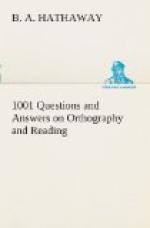41. What is Pronunciation?
The distinct utterance of the sounds of
a word.
42. What are the significant parts
of a word?
Root, prefix, and suffix.
43. How are words divided as to variety?
Italic, Roman, Old English, etc.
44. Name some compound word in which
both parts retain their own
accent.
Writ’ing-mas’ter.
45. Name some word in which one part
loses its accent.
Gentle-manly.
46. Can all the vowels form syllables
themselves?
All except W.
47. When has R a rough sound?
When it begins a word.
48. How are words distinguished?
By their forms and uses.
49. Why do Consonants ever unite?
To form complex sounds: as rr in
Burr.
50. From what language are most words
derived that end in less?
Anglo-Saxon.
51. Is Z the last letter of all alphabets?
All except the Greek, and Hebrew.
52. What is its place in the Greek
alphabet?
Sixth.
53. What is its place in the Hebrew?
Seventh.
54. What letter is the sonorous counterpart
of S?
The letter Z.—Cyclopedia.
55. What is spelling of Z in England?
Zed, and also Izzard.
56. What language has two letters representing
the sound of Z?
The Russian.
57. When was the letter W first used?
About the end of the Seventh Century.
58. What changes the sound of a vowel
from long to short?
The absence of the accent.
59. In what situation is gh always
silent?
After i in the same syllable.
60. How many words of two syllables
are changed from nouns to
verbs
by accent?
About eighty.
61. What word contains a consonant
Tetragraph?
Phthisic.
62. What is Philology?
The science of language.
63. When is ue final, silent?
After g and q; as fatigue and oblique.
64. What are the elements of spoken
language?
Vocal and articulate sounds.
65. What are Hybrid words?
Mongrel compounds.
66. What is Terminology?
A treatise on technicalities.
READING AND ELOCUTION.
1. What is Reading?
Silent perusal or distinct utterance of
thought and feeling, as
seen
expressed in written language.
2. How many kinds of Reading are there?
Two.
3. What are they?
Silent and Audible.
4. What is Silent Reading?
The perusal of Language without utterance.
5. What is Audible Reading?
The utterance of thought and feeling,
as seen expressed in written
Language.




